1988 OPEL CALIBRA ECO mode
[x] Cancel search: ECO modePage 100 of 525
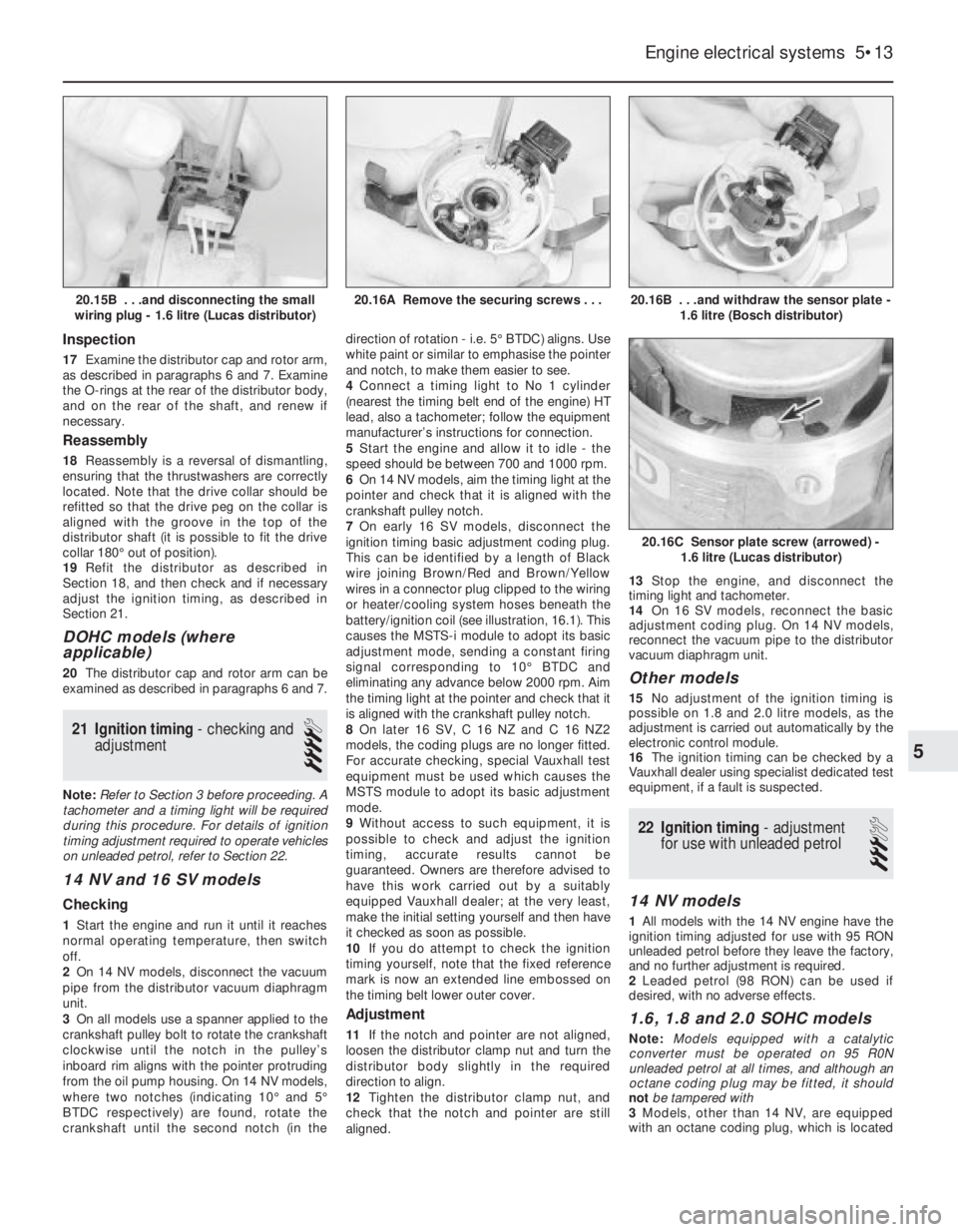
Inspection
17Examine the distributor cap and rotor arm,
as described in paragraphs 6 and 7. Examine
the O-rings at the rear of the distributor body,
and on the rear of the shaft, and renew if
necessary.
Reassembly
18Reassembly is a reversal of dismantling,
ensuring that the thrustwashers are correctly
located. Note that the drive collar should be
refitted so that the drive peg on the collar is
aligned with the groove in the top of the
distributor shaft (it is possible to fit the drive
collar 180°out of position).
19Refit the distributor as described in
Section 18, and then check and if necessary
adjust the ignition timing, as described in
Section 21.
DOHC models (where
applicable)
20The distributor cap and rotor arm can be
examined as described in paragraphs 6 and 7.
21Ignition timing -checking and
adjustment
4
Note: Refer to Section 3 before proceeding. A
tachometer and a timing light will be required
during this procedure. For details of ignition
timing adjustment required to operate vehicles
on unleaded petrol, refer to Section 22.
14 NV and 16 SV models
Checking
1Start the engine and run it until it reaches
normal operating temperature, then switch
off.
2On 14 NV models, disconnect the vacuum
pipe from the distributor vacuum diaphragm
unit.
3On all models use a spanner applied to the
crankshaft pulley bolt to rotate the crankshaft
clockwise until the notch in the pulley’s
inboard rim aligns with the pointer protruding
from the oil pump housing. On 14 NV models,
where two notches (indicating 10°and 5°
BTDC respectively) are found, rotate the
crankshaft until the second notch (in thedirection of rotation -i.e. 5°BTDC) aligns. Use
white paint or similar to emphasise the pointer
and notch, to make them easier to see.
4Connect a timing light to No 1 cylinder
(nearest the timing belt end of the engine) HT
lead, also a tachometer; follow the equipment
manufacturer’s instructions for connection.
5Start the engine and allow it to idle -the
speed should be between 700 and 1000 rpm.
6On 14 NV models, aim the timing light at the
pointer and check that it is aligned with the
crankshaft pulley notch.
7On early 16 SV models, disconnect the
ignition timing basic adjustment coding plug.
This can be identified by a length of Black
wire joining Brown/Red and Brown/Yellow
wires in a connector plug clipped to the wiring
or heater/cooling system hoses beneath the
battery/ignition coil (see illustration, 16.1). This
causes the MSTS-i module to adopt its basic
adjustment mode, sending a constant firing
signal corresponding to 10°BTDC and
eliminating any advance below 2000 rpm. Aim
the timing light at the pointer and check that it
is aligned with the crankshaft pulley notch.
8On later 16 SV, C 16 NZ and C 16 NZ2
models, the coding plugs are no longer fitted.
For accurate checking, special Vauxhall test
equipment must be used which causes the
MSTS module to adopt its basic adjustment
mode.
9Without access to such equipment, it is
possible to check and adjust the ignition
timing, accurate results cannot be
guaranteed. Owners are therefore advised to
have this work carried out by a suitably
equipped Vauxhall dealer; at the very least,
make the initial setting yourself and then have
it checked as soon as possible.
10If you do attempt to check the ignition
timing yourself, note that the fixed reference
mark is now an extended line embossed on
the timing belt lower outer cover.
Adjustment
11If the notch and pointer are not aligned,
loosen the distributor clamp nut and turn the
distributor body slightly in the required
direction to align.
12Tighten the distributor clamp nut, and
check that the notch and pointer are still
aligned. 13Stop the engine, and disconnect the
timing light and tachometer.
14On 16 SV models, reconnect the basic
adjustment coding plug. On 14 NV models,
reconnect the vacuum pipe to the distributor
vacuum diaphragm unit.
Other models
15No adjustment of the ignition timing is
possible on 1.8 and 2.0 litre models, as the
adjustment is carried out automatically by the
electronic control module.
16The ignition timing can be checked by a
Vauxhall dealer using specialist dedicated test
equipment, if a fault is suspected.
22Ignition timing -adjustment
for use with unleaded petrol
3
14 NV models
1All models with the 14 NV engine have the
ignition timing adjusted for use with 95 RON
unleaded petrol before they leave the factory,
and no further adjustment is required.
2Leaded petrol (98 RON) can be used if
desired, with no adverse effects.
1.6, 1.8 and 2.0 SOHC models
Note: Models equipped with a catalytic
converter must be operated on 95 R0N
unleaded petrol at all times, and although an
octane coding plug may be fitted, it should
not be tampered with
3Models, other than 14 NV, are equipped
with an octane coding plug, which is located
Engine electrical systems 5•13
20.16B . . .and withdraw the sensor plate -
1.6 litre (Bosch distributor)
20.16C Sensor plate screw (arrowed) -
1.6 litre (Lucas distributor)
20.16A Remove the securing screws . . .20.15B . . .and disconnecting the small
wiring plug - 1.6 litre (Lucas distributor)
5
Page 101 of 525
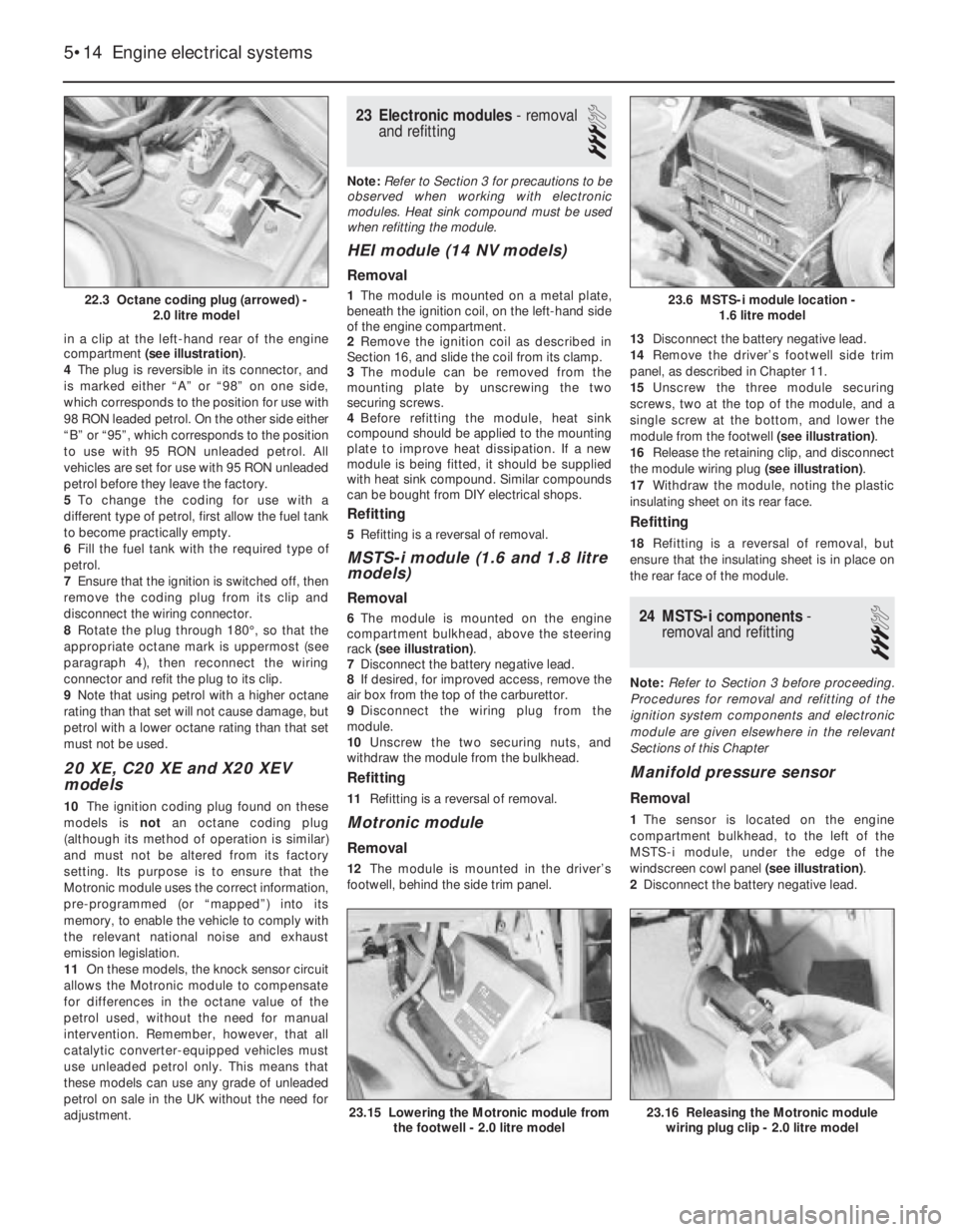
in a clip at the left-hand rear of the engine
compartment (see illustration).
4The plug is reversible in its connector, and
is marked either “A” or “98” on one side,
which corresponds to the position for use with
98 RON leaded petrol. On the other side either
“B” or “95”, which corresponds to the position
to use with 95 RON unleaded petrol. All
vehicles are set for use with 95 RON unleaded
petrol before they leave the factory.
5To change the coding for use with a
different type of petrol, first allow the fuel tank
to become practically empty.
6Fill the fuel tank with the required type of
petrol.
7Ensure that the ignition is switched off, then
remove the coding plug from its clip and
disconnect the wiring connector.
8Rotate the plug through 180°, so that the
appropriate octane mark is uppermost (see
paragraph 4), then reconnect the wiring
connector and refit the plug to its clip.
9Note that using petrol with a higher octane
rating than that set will not cause damage, but
petrol with a lower octane rating than that set
must not be used.
20 XE, C20 XE and X20 XEV
models
10The ignition coding plug found on these
models is not an octane coding plug
(although its method of operation is similar)
and must not be altered from its factory
setting. Its purpose is to ensure that the
Motronic module uses the correct information,
pre-programmed (or “mapped”) into its
memory, to enable the vehicle to comply with
the relevant national noise and exhaust
emission legislation.
11On these models, the knock sensor circuit
allows the Motronic module to compensate
for differences in the octane value of the
petrol used, without the need for manual
intervention. Remember, however, that all
catalytic converter-equipped vehicles must
use unleaded petrol only. This means that
these models can use any grade of unleaded
petrol on sale in the UK without the need for
adjustment.
23Electronic modules - removal
and refitting
3
Note: Refer to Section 3 for precautions to be
observed when working with electronic
modules. Heat sink compound must be used
when refitting the module.
HEI module (14 NV models)
Removal
1The module is mounted on a metal plate,
beneath the ignition coil, on the left-hand side
of the engine compartment.
2Remove the ignition coil as described in
Section 16, and slide the coil from its clamp.
3The module can be removed from the
mounting plate by unscrewing the two
securing screws.
4Before refitting the module, heat sink
compound should be applied to the mounting
plate to improve heat dissipation. If a new
module is being fitted, it should be supplied
with heat sink compound. Similar compounds
can be bought from DIY electrical shops.
Refitting
5Refitting is a reversal of removal.
MSTS-i module (1.6 and 1.8 litre
models)
Removal
6The module is mounted on the engine
compartment bulkhead, above the steering
rack (see illustration).
7Disconnect the battery negative lead.
8If desired, for improved access, remove the
air box from the top of the carburettor.
9Disconnect the wiring plug from the
module.
10Unscrew the two securing nuts, and
withdraw the module from the bulkhead.
Refitting
11Refitting is a reversal of removal.
Motronic module
Removal
12The module is mounted in the driver’s
footwell, behind the side trim panel.13Disconnect the battery negative lead.
14Remove the driver’s footwell side trim
panel, as described in Chapter 11.
15Unscrew the three module securing
screws, two at the top of the module, and a
single screw at the bottom, and lower the
module from the footwell (see illustration).
16Release the retaining clip, and disconnect
the module wiring plug (see illustration).
17Withdraw the module, noting the plastic
insulating sheet on its rear face.
Refitting
18Refitting is a reversal of removal, but
ensure that the insulating sheet is in place on
the rear face of the module.
24MSTS-i components -
removal and refitting
3
Note: Refer to Section 3 before proceeding.
Procedures for removal and refitting of the
ignition system components and electronic
module are given elsewhere in the relevant
Sections of this Chapter
Manifold pressure sensor
Removal
1The sensor is located on the engine
compartment bulkhead, to the left of the
MSTS-i module, under the edge of the
windscreen cowl panel (see illustration).
2Disconnect the battery negative lead.
5•14Engine electrical systems
22.3 Octane coding plug (arrowed) -
2.0 litre model
23.15 Lowering the Motronic module from
the footwell - 2.0 litre model23.16 Releasing the Motronic module
wiring plug clip - 2.0 litre model
23.6 MSTS-i module location -
1.6 litre model
Page 107 of 525
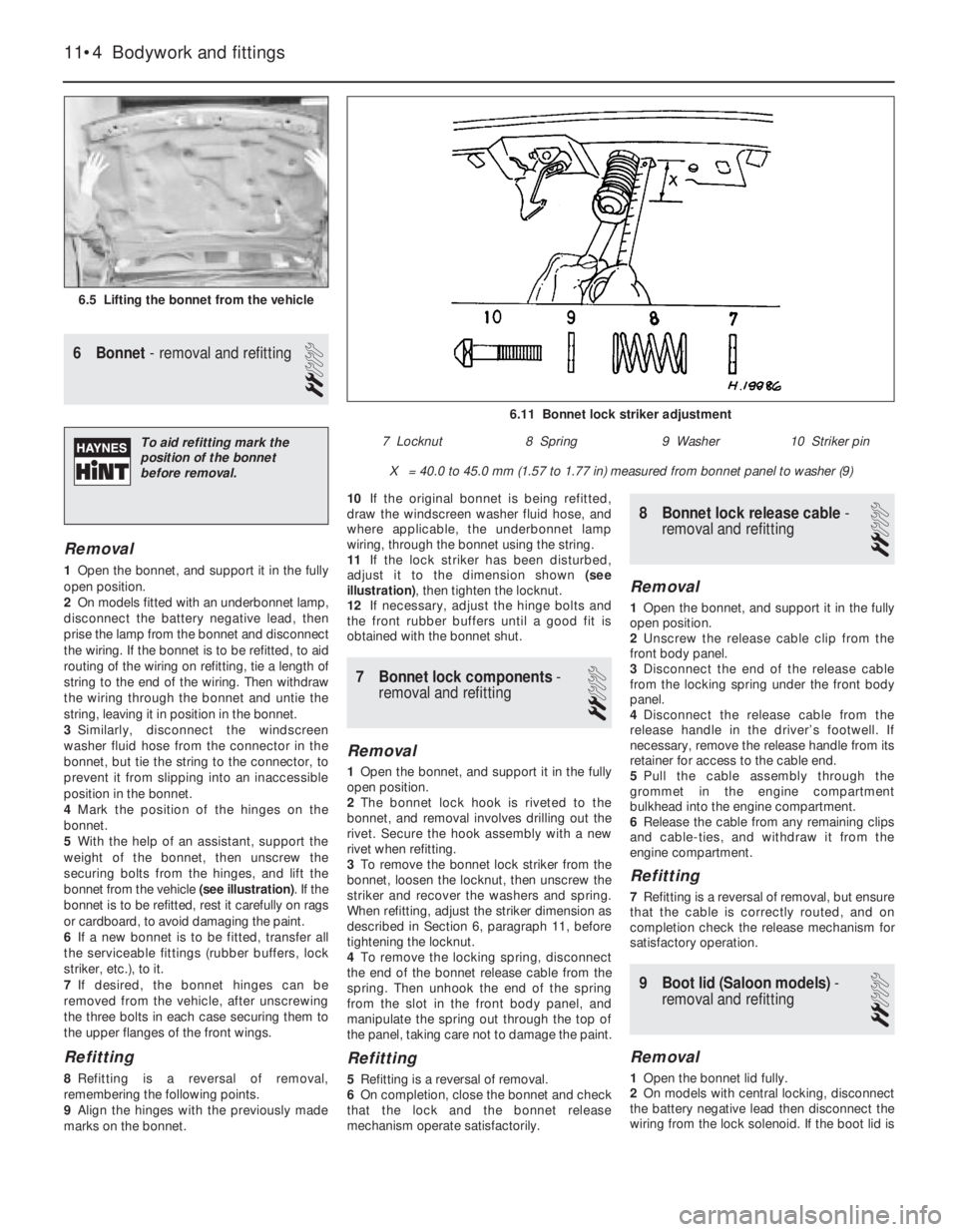
6Bonnet - removal and refitting
2
Removal
1Open the bonnet, and support it in the fully
open position.
2On models fitted with an underbonnet lamp,
disconnect the battery negative lead, then
prise the lamp from the bonnet and disconnect
the wiring. If the bonnet is to be refitted, to aid
routing of the wiring on refitting, tie a length of
string to the end of the wiring. Then withdraw
the wiring through the bonnet and untie the
string, leaving it in position in the bonnet.
3Similarly, disconnect the windscreen
washer fluid hose from the connector in the
bonnet, but tie the string to the connector, to
prevent it from slipping into an inaccessible
position in the bonnet.
4Mark the position of the hinges on the
bonnet.
5With the help of an assistant, support the
weight of the bonnet, then unscrew the
securing bolts from the hinges, and lift the
bonnet from the vehicle (see illustration). If the
bonnet is to be refitted, rest it carefully on rags
or cardboard, to avoid damaging the paint.
6If a new bonnet is to be fitted, transfer all
the serviceable fittings (rubber buffers, lock
striker, etc.), to it.
7If desired, the bonnet hinges can be
removed from the vehicle, after unscrewing
the three bolts in each case securing them to
the upper flanges of the front wings.
Refitting
8Refitting is a reversal of removal,
remembering the following points.
9Align the hinges with the previously made
marks on the bonnet.10If the original bonnet is being refitted,
draw the windscreen washer fluid hose, and
where applicable, the underbonnet lamp
wiring, through the bonnet using the string.
11If the lock striker has been disturbed,
adjust it to the dimension shown (see
illustration), then tighten the locknut.
12If necessary, adjust the hinge bolts and
the front rubber buffers until a good fit is
obtained with the bonnet shut.
7Bonnet lock components -
removal and refitting
2
Removal
1Open the bonnet, and support it in the fully
open position.
2The bonnet lock hook is riveted to the
bonnet, and removal involves drilling out the
rivet. Secure the hook assembly with a new
rivet when refitting.
3To remove the bonnet lock striker from the
bonnet, loosen the locknut, then unscrew the
striker and recover the washers and spring.
When refitting, adjust the striker dimension as
described in Section 6, paragraph 11, before
tightening the locknut.
4To remove the locking spring, disconnect
the end of the bonnet release cable from the
spring. Then unhook the end of the spring
from the slot in the front body panel, and
manipulate the spring out through the top of
the panel, taking care not to damage the paint.
Refitting
5Refitting is a reversal of removal.
6On completion, close the bonnet and check
that the lock and the bonnet release
mechanism operate satisfactorily.
8Bonnet lock release cable -
removal and refitting
2
Removal
1Open the bonnet, and support it in the fully
open position.
2Unscrew the release cable clip from the
front body panel.
3Disconnect the end of the release cable
from the locking spring under the front body
panel.
4Disconnect the release cable from the
release handle in the driver’s footwell. If
necessary, remove the release handle from its
retainer for access to the cable end.
5Pull the cable assembly through the
grommet in the engine compartment
bulkhead into the engine compartment.
6Release the cable from any remaining clips
and cable-ties, and withdraw it from the
engine compartment.
Refitting
7Refitting is a reversal of removal, but ensure
that the cable is correctly routed, and on
completion check the release mechanism for
satisfactory operation.
9Boot lid (Saloon models) -
removal and refitting
2
Removal
1Open the bonnet lid fully.
2On models with central locking, disconnect
the battery negative lead then disconnect the
wiring from the lock solenoid. If the boot lid is
11•4Bodywork and fittings
6.5 Lifting the bonnet from the vehicle
6.11 Bonnet lock striker adjustment
X = 40.0 to 45.0 mm (1.57 to 1.77 in) measured from bonnet panel to washer (9)
7 Locknut8 Spring9 Washer10 Striker pinTo aid refitting mark the
position of the bonnet
before removal.
Page 111 of 525
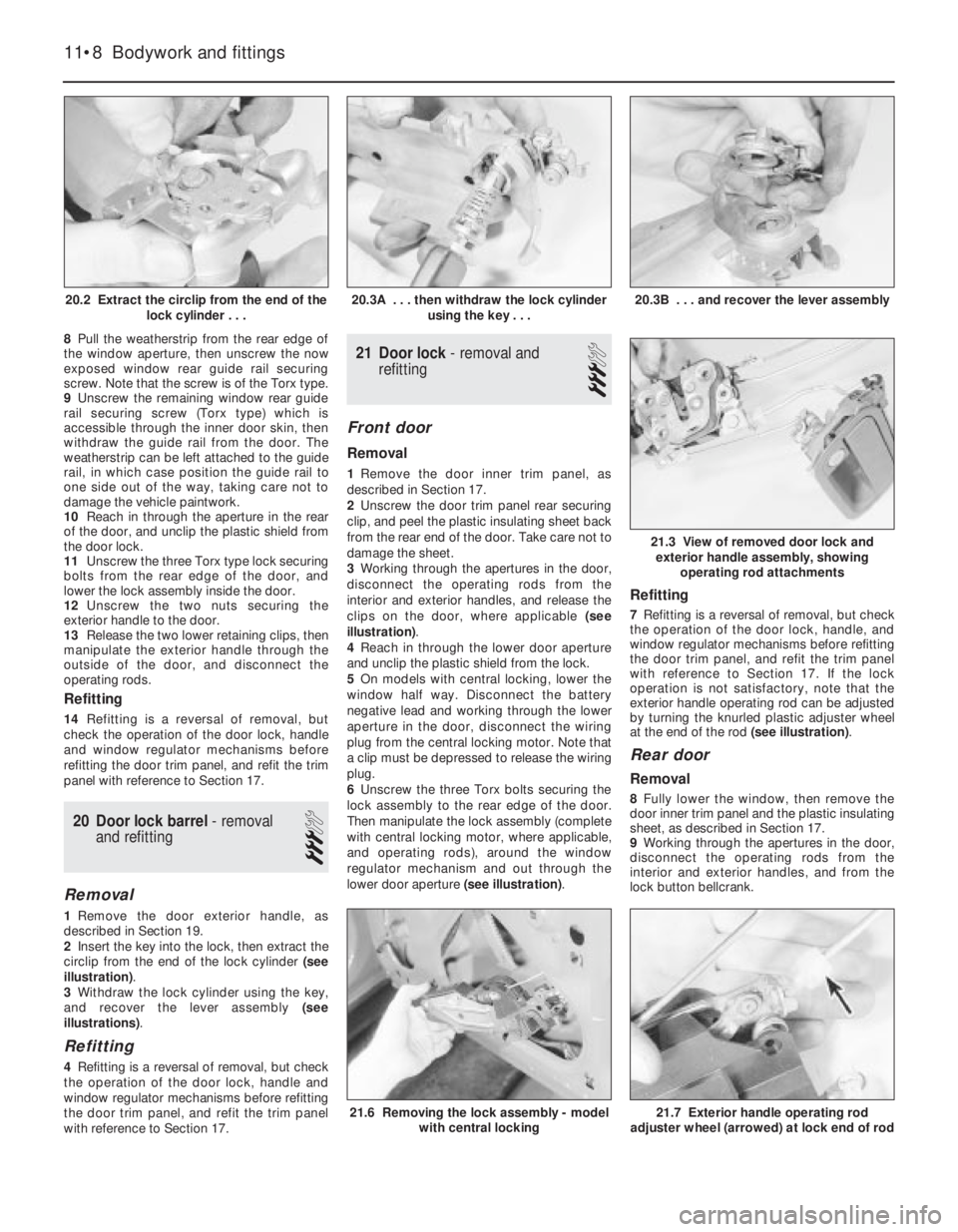
8Pull the weatherstrip from the rear edge of
the window aperture, then unscrew the now
exposed window rear guide rail securing
screw. Note that the screw is of the Torx type.
9Unscrew the remaining window rear guide
rail securing screw (Torx type) which is
accessible through the inner door skin, then
withdraw the guide rail from the door. The
weatherstrip can be left attached to the guide
rail, in which case position the guide rail to
one side out of the way, taking care not to
damage the vehicle paintwork.
10Reach in through the aperture in the rear
of the door, and unclip the plastic shield from
the door lock.
11Unscrew the three Torx type lock securing
bolts from the rear edge of the door, and
lower the lock assembly inside the door.
12Unscrew the two nuts securing the
exterior handle to the door.
13Release the two lower retaining clips, then
manipulate the exterior handle through the
outside of the door, and disconnect the
operating rods.
Refitting
14Refitting is a reversal of removal, but
check the operation of the door lock, handle
and window regulator mechanisms before
refitting the door trim panel, and refit the trim
panel with reference to Section 17.
20Door lock barrel - removal
and refitting
3
Removal
1Remove the door exterior handle, as
described in Section 19.
2Insert the key into the lock, then extract the
circlip from the end of the lock cylinder (see
illustration).
3Withdraw the lock cylinder using the key,
and recover the lever assembly (see
illustrations).
Refitting
4 Refitting is a reversal of removal, but check
the operation of the door lock, handle and
window regulator mechanisms before refitting
the door trim panel, and refit the trim panel
with reference to Section 17.
21Door lock -removal and
refitting
3
Front door
Removal
1Remove the door inner trim panel, as
described in Section 17.
2Unscrew the door trim panel rear securing
clip, and peel the plastic insulating sheet back
from the rear end of the door. Take care not to
damage the sheet.
3Working through the apertures in the door,
disconnect the operating rods from the
interior and exterior handles, and release the
clips on the door, where applicable (see
illustration).
4Reach in through the lower door aperture
and unclip the plastic shield from the lock.
5On models with central locking, lower the
window half way. Disconnect the battery
negative lead and working through the lower
aperture in the door, disconnect the wiring
plug from the central locking motor. Note that
a clip must be depressed to release the wiring
plug.
6Unscrew the three Torx bolts securing the
lock assembly to the rear edge of the door.
Then manipulate the lock assembly (complete
with central locking motor, where applicable,
and operating rods), around the window
regulator mechanism and out through the
lower door aperture (see illustration).
Refitting
7Refitting is a reversal of removal, but check
the operation of the door lock, handle, and
window regulator mechanisms before refitting
the door trim panel, and refit the trim panel
with reference to Section 17. If the lock
operation is not satisfactory, note that the
exterior handle operating rod can be adjusted
by turning the knurled plastic adjuster wheel
at the end of the rod (see illustration).
Rear door
Removal
8Fully lower the window, then remove the
door inner trim panel and the plastic insulating
sheet, as described in Section 17.
9Working through the apertures in the door,
disconnect the operating rods from the
interior and exterior handles, and from the
lock button bellcrank.
11•8Bodywork and fittings
20.2 Extract the circlip from the end of the
lock cylinder . . .20.3B . . . and recover the lever assembly
21.7 Exterior handle operating rod
adjuster wheel (arrowed) at lock end of rod21.6 Removing the lock assembly - model
with central locking
21.3 View of removed door lock and
exterior handle assembly, showing
operating rod attachments
20.3A . . . then withdraw the lock cylinder
using the key . . .
Page 112 of 525
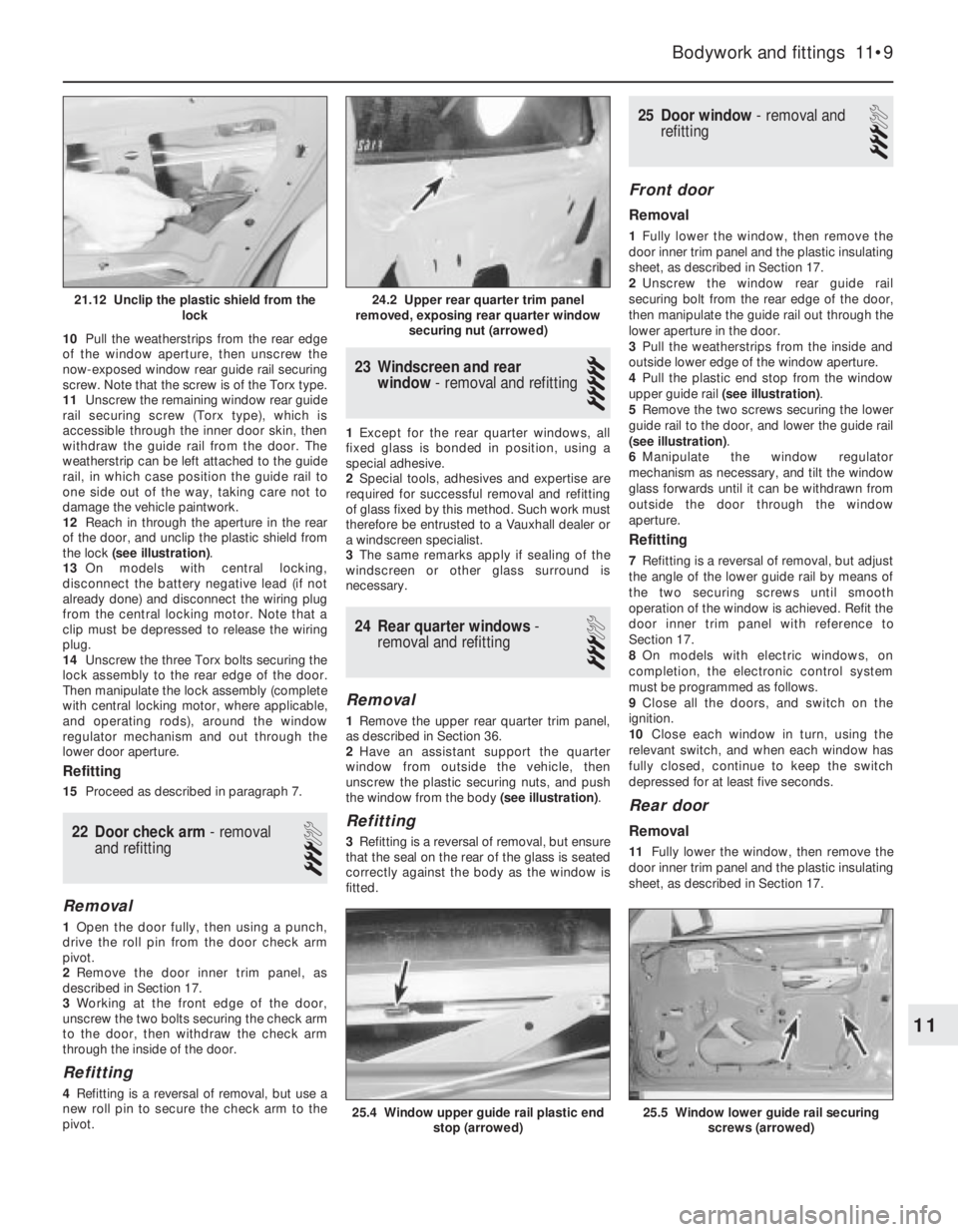
10Pull the weatherstrips from the rear edge
of the window aperture, then unscrew the
now-exposed window rear guide rail securing
screw. Note that the screw is of the Torx type.
11Unscrew the remaining window rear guide
rail securing screw (Torx type), which is
accessible through the inner door skin, then
withdraw the guide rail from the door. The
weatherstrip can be left attached to the guide
rail, in which case position the guide rail to
one side out of the way, taking care not to
damage the vehicle paintwork.
12Reach in through the aperture in the rear
of the door, and unclip the plastic shield from
the lock (see illustration).
13On models with central locking,
disconnect the battery negative lead (if not
already done) and disconnect the wiring plug
from the central locking motor. Note that a
clip must be depressed to release the wiring
plug.
14Unscrew the three Torx bolts securing the
lock assembly to the rear edge of the door.
Then manipulate the lock assembly (complete
with central locking motor, where applicable,
and operating rods), around the window
regulator mechanism and out through the
lower door aperture.
Refitting
15Proceed as described in paragraph 7.
22Door check arm -removal
and refitting
3
Removal
1Open the door fully, then using a punch,
drive the roll pin from the door check arm
pivot.
2Remove the door inner trim panel, as
described in Section 17.
3Working at the front edge of the door,
unscrew the two bolts securing the check arm
to the door, then withdraw the check arm
through the inside of the door.
Refitting
4Refitting is a reversal of removal, but use a
new roll pin to secure the check arm to the
pivot.
23Windscreen and rear
window - removal and refitting
5
1Except for the rear quarter windows, all
fixed glass is bonded in position, using a
special adhesive.
2Special tools, adhesives and expertise are
required for successful removal and refitting
of glass fixed by this method. Such work must
therefore be entrusted to a Vauxhall dealer or
a windscreen specialist.
3The same remarks apply if sealing of the
windscreen or other glass surround is
necessary.
24Rear quarter windows -
removal and refitting
3
Removal
1Remove the upper rear quarter trim panel,
as described in Section 36.
2Have an assistant support the quarter
window from outside the vehicle, then
unscrew the plastic securing nuts, and push
the window from the body (see illustration).
Refitting
3Refitting is a reversal of removal, but ensure
that the seal on the rear of the glass is seated
correctly against the body as the window is
fitted.
25Door window - removal and
refitting
3
Front door
Removal
1Fully lower the window, then remove the
door inner trim panel and the plastic insulating
sheet, as described in Section 17.
2Unscrew the window rear guide rail
securing bolt from the rear edge of the door,
then manipulate the guide rail out through the
lower aperture in the door.
3Pull the weatherstrips from the inside and
outside lower edge of the window aperture.
4Pull the plastic end stop from the window
upper guide rail (see illustration).
5Remove the two screws securing the lower
guide rail to the door, and lower the guide rail
(see illustration).
6Manipulate the window regulator
mechanism as necessary, and tilt the window
glass forwards until it can be withdrawn from
outside the door through the window
aperture.
Refitting
7Refitting is a reversal of removal, but adjust
the angle of the lower guide rail by means of
the two securing screws until smooth
operation of the window is achieved. Refit the
door inner trim panel with reference to
Section 17.
8On models with electric windows, on
completion, the electronic control system
must be programmed as follows.
9Close all the doors, and switch on the
ignition.
10Close each window in turn, using the
relevant switch, and when each window has
fully closed, continue to keep the switch
depressed for at least five seconds.
Rear door
Removal
11Fully lower the window, then remove the
door inner trim panel and the plastic insulating
sheet, as described in Section 17.
Bodywork and fittings 11•9
25.4 Window upper guide rail plastic end
stop (arrowed)25.5 Window lower guide rail securing
screws (arrowed)
24.2 Upper rear quarter trim panel
removed, exposing rear quarter window
securing nut (arrowed)21.12 Unclip the plastic shield from the
lock
11
Page 115 of 525
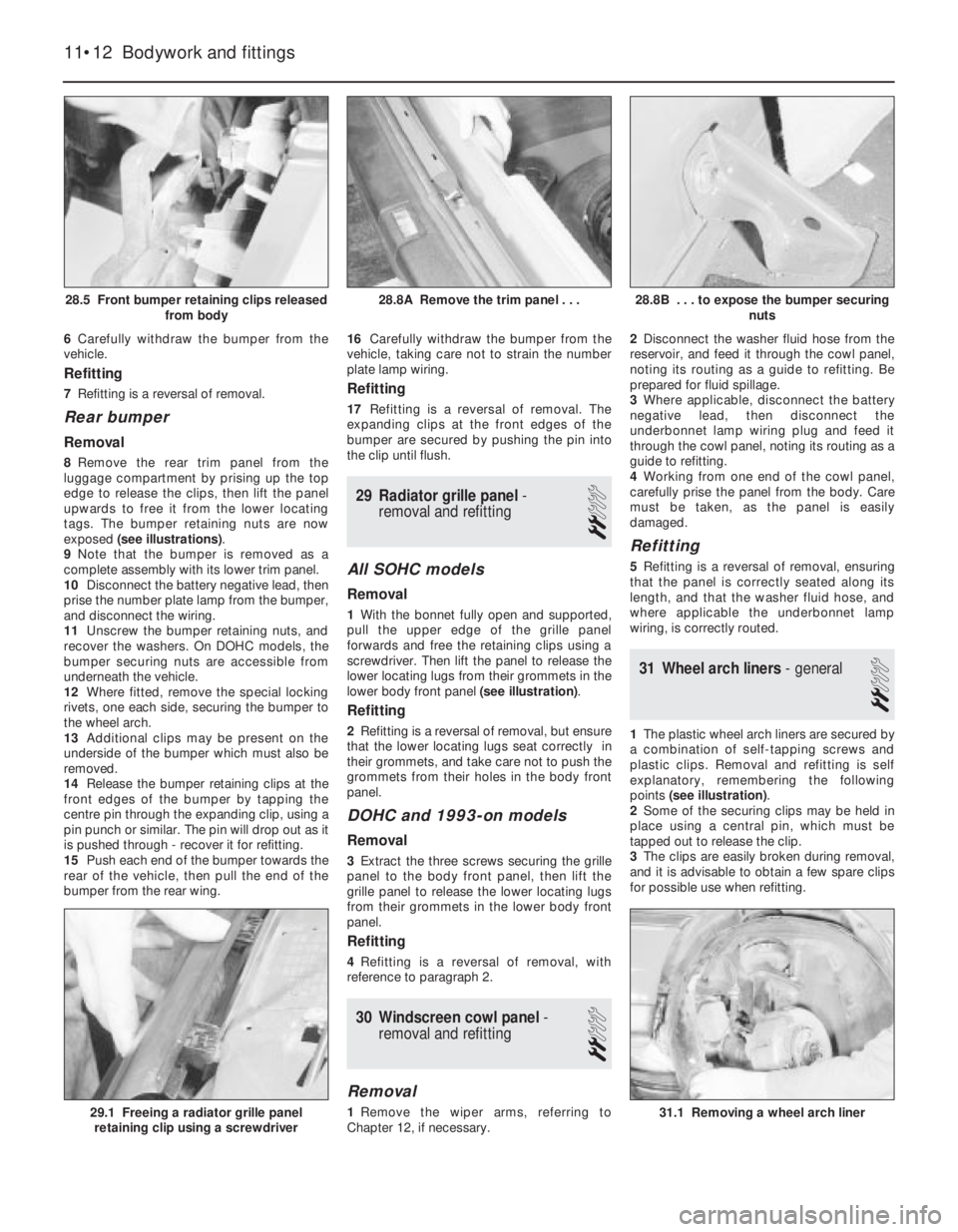
6Carefully withdraw the bumper from the
vehicle.
Refitting
7Refitting is a reversal of removal.
Rear bumper
Removal
8Remove the rear trim panel from the
luggage compartment by prising up the top
edge to release the clips, then lift the panel
upwards to free it from the lower locating
tags. The bumper retaining nuts are now
exposed (see illustrations).
9Note that the bumper is removed as a
complete assembly with its lower trim panel.
10Disconnect the battery negative lead, then
prise the number plate lamp from the bumper,
and disconnect the wiring.
11Unscrew the bumper retaining nuts, and
recover the washers. On DOHC models, the
bumper securing nuts are accessible from
underneath the vehicle.
12Where fitted, remove the special locking
rivets, one each side, securing the bumper to
the wheel arch.
13Additional clips may be present on the
underside of the bumper which must also be
removed.
14Release the bumper retaining clips at the
front edges of the bumper by tapping the
centre pin through the expanding clip, using a
pin punch or similar. The pin will drop out as it
is pushed through - recover it for refitting.
15Push each end of the bumper towards the
rear of the vehicle, then pull the end of the
bumper from the rear wing.16Carefully withdraw the bumper from the
vehicle, taking care not to strain the number
plate lamp wiring.
Refitting
17Refitting is a reversal of removal. The
expanding clips at the front edges of the
bumper are secured by pushing the pin into
the clip until flush.
29Radiator grille panel -
removal and refitting
2
All SOHC models
Removal
1With the bonnet fully open and supported,
pull the upper edge of the grille panel
forwards and free the retaining clips using a
screwdriver. Then lift the panel to release the
lower locating lugs from their grommets in the
lower body front panel (see illustration).
Refitting
2Refitting is a reversal of removal, but ensure
that the lower locating lugs seat correctly in
their grommets, and take care not to push the
grommets from their holes in the body front
panel.
DOHC and 1993-on models
Removal
3Extract the three screws securing the grille
panel to the body front panel, then lift the
grille panel to release the lower locating lugs
from their grommets in the lower body front
panel.
Refitting
4Refitting is a reversal of removal, with
reference to paragraph 2.
30Windscreen cowl panel -
removal and refitting
2
Removal
1Remove the wiper arms, referring to
Chapter 12, if necessary.2Disconnect the washer fluid hose from the
reservoir, and feed it through the cowl panel,
noting its routing as a guide to refitting. Be
prepared for fluid spillage.
3Where applicable, disconnect the battery
negative lead, then disconnect the
underbonnet lamp wiring plug and feed it
through the cowl panel, noting its routing as a
guide to refitting.
4Working from one end of the cowl panel,
carefully prise the panel from the body. Care
must be taken, as the panel is easily
damaged.
Refitting
5Refitting is a reversal of removal, ensuring
that the panel is correctly seated along its
length, and that the washer fluid hose, and
where applicable the underbonnet lamp
wiring, is correctly routed.
31Wheel arch liners - general
2
1The plastic wheel arch liners are secured by
a combination of self-tapping screws and
plastic clips. Removal and refitting is self
explanatory, remembering the following
points (see illustration).
2Some of the securing clips may be held in
place using a central pin, which must be
tapped out to release the clip.
3The clips are easily broken during removal,
and it is advisable to obtain a few spare clips
for possible use when refitting.
11•12Bodywork and fittings
28.8B . . . to expose the bumper securing
nuts
31.1 Removing a wheel arch liner29.1 Freeing a radiator grille panel
retaining clip using a screwdriver
28.8A Remove the trim panel . . .28.5 Front bumper retaining clips released
from body
Page 116 of 525
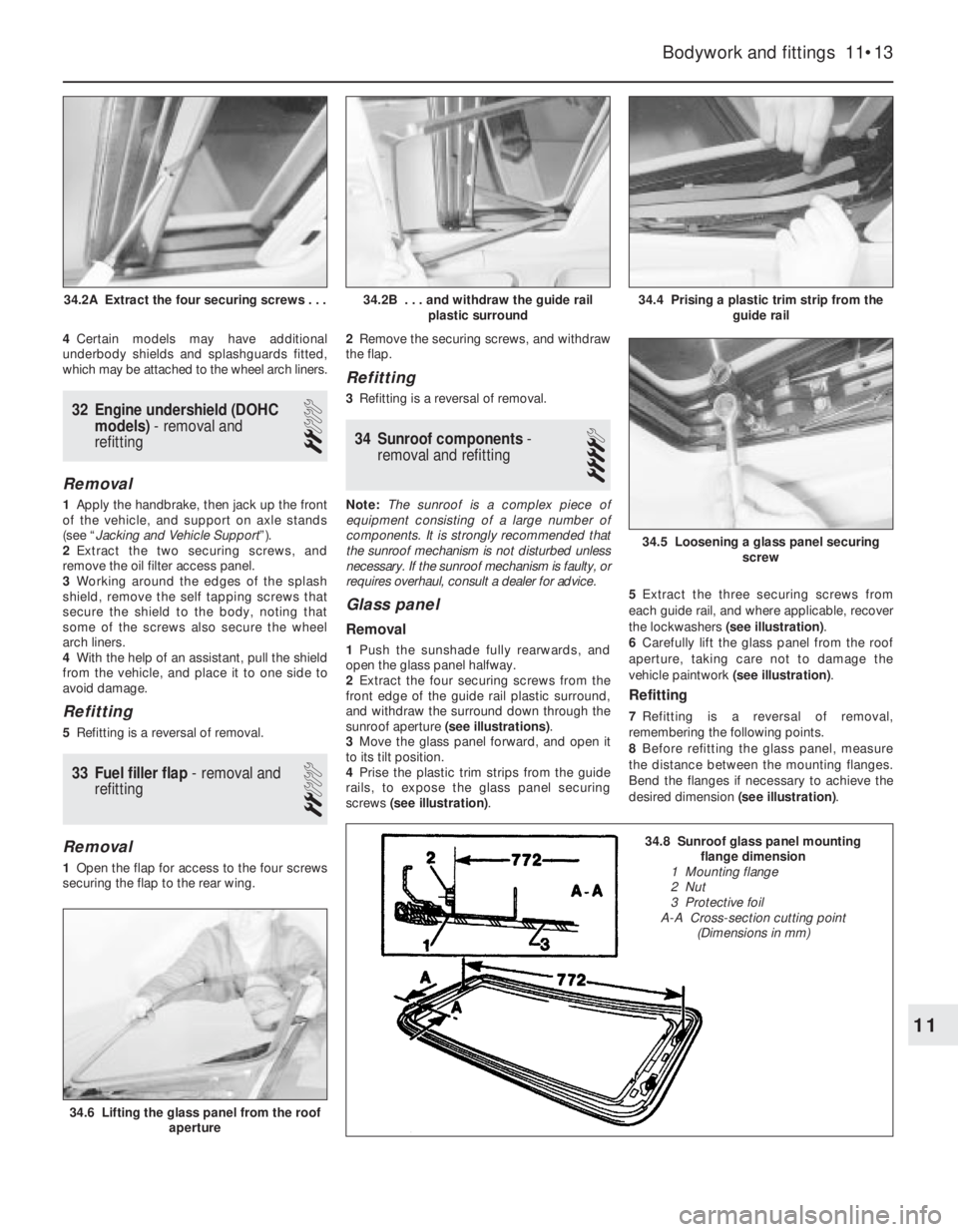
4Certain models may have additional
underbody shields and splashguards fitted,
which may be attached to the wheel arch liners.
32Engine undershield (DOHC
models) - removal and
refitting
2
Removal
1Apply the handbrake, then jack up the front
of the vehicle, and support on axle stands
(see “Jacking and Vehicle Support”).
2Extract the two securing screws, and
remove the oil filter access panel.
3Working around the edges of the splash
shield, remove the self tapping screws that
secure the shield to the body, noting that
some of the screws also secure the wheel
arch liners.
4With the help of an assistant, pull the shield
from the vehicle, and place it to one side to
avoid damage.
Refitting
5Refitting is a reversal of removal.
33Fuel filler flap -removal and
refitting
2
Removal
1Open the flap for access to the four screws
securing the flap to the rear wing.2Remove the securing screws, and withdraw
the flap.
Refitting
3Refitting is a reversal of removal.
34Sunroof components -
removal and refitting
4
Note:The sunroof is a complex piece of
equipment consisting of a large number of
components. It is strongly recommended that
the sunroof mechanism is not disturbed unless
necessary. If the sunroof mechanism is faulty, or
requires overhaul, consult a dealer for advice.
Glass panel
Removal
1Push the sunshade fully rearwards, and
open the glass panel halfway.
2Extract the four securing screws from the
front edge of the guide rail plastic surround,
and withdraw the surround down through the
sunroof aperture (see illustrations).
3Move the glass panel forward, and open it
to its tilt position.
4Prise the plastic trim strips from the guide
rails, to expose the glass panel securing
screws (see illustration).5Extract the three securing screws from
each guide rail, and where applicable, recover
the lockwashers (see illustration).
6Carefully lift the glass panel from the roof
aperture, taking care not to damage the
vehicle paintwork (see illustration).
Refitting
7Refitting is a reversal of removal,
remembering the following points.
8Before refitting the glass panel, measure
the distance between the mounting flanges.
Bend the flanges if necessary to achieve the
desired dimension (see illustration).
Bodywork and fittings 11•13
34.4 Prising a plastic trim strip from the
guide rail
34.6 Lifting the glass panel from the roof
aperture
34.5 Loosening a glass panel securing
screw
34.2B . . . and withdraw the guide rail
plastic surround34.2A Extract the four securing screws . . .
11
34.8 Sunroof glass panel mounting
flange dimension
1 Mounting flange
2 Nut
3 Protective foil
A-A Cross-section cutting point
(Dimensions in mm)
Page 118 of 525
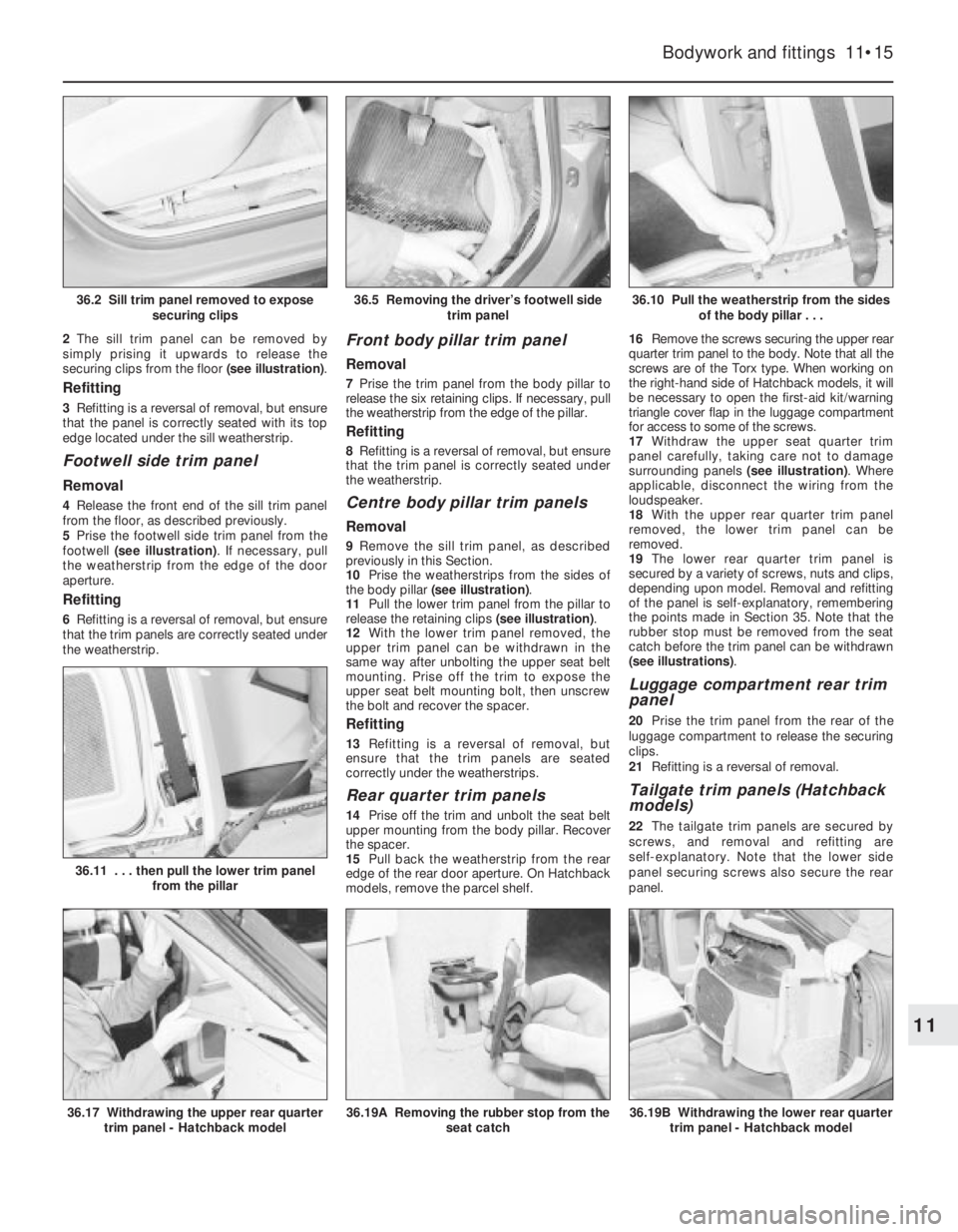
2The sill trim panel can be removed by
simply prising it upwards to release the
securing clips from the floor (see illustration).
Refitting
3Refitting is a reversal of removal, but ensure
that the panel is correctly seated with its top
edge located under the sill weatherstrip.
Footwell side trim panel
Removal
4Release the front end of the sill trim panel
from the floor, as described previously.
5Prise the footwell side trim panel from the
footwell (see illustration). If necessary, pull
the weatherstrip from the edge of the door
aperture.
Refitting
6Refitting is a reversal of removal, but ensure
that the trim panels are correctly seated under
the weatherstrip.
Front body pillar trim panel
Removal
7Prise the trim panel from the body pillar to
release the six retaining clips. If necessary, pull
the weatherstrip from the edge of the pillar.
Refitting
8Refitting is a reversal of removal, but ensure
that the trim panel is correctly seated under
the weatherstrip.
Centre body pillar trim panels
Removal
9Remove the sill trim panel, as described
previously in this Section.
10Prise the weatherstrips from the sides of
the body pillar (see illustration).
11Pull the lower trim panel from the pillar to
release the retaining clips (see illustration).
12With the lower trim panel removed, the
upper trim panel can be withdrawn in the
same way after unbolting the upper seat belt
mounting. Prise off the trim to expose the
upper seat belt mounting bolt, then unscrew
the bolt and recover the spacer.
Refitting
13Refitting is a reversal of removal, but
ensure that the trim panels are seated
correctly under the weatherstrips.
Rear quarter trim panels
14Prise off the trim and unbolt the seat belt
upper mounting from the body pillar. Recover
the spacer.
15Pull back the weatherstrip from the rear
edge of the rear door aperture. On Hatchback
models, remove the parcel shelf.16Remove the screws securing the upper rear
quarter trim panel to the body. Note that all the
screws are of the Torx type. When working on
the right-hand side of Hatchback models, it will
be necessary to open the first-aid kit/warning
triangle cover flap in the luggage compartment
for access to some of the screws.
17Withdraw the upper seat quarter trim
panel carefully, taking care not to damage
surrounding panels (see illustration). Where
applicable, disconnect the wiring from the
loudspeaker.
18With the upper rear quarter trim panel
removed, the lower trim panel can be
removed.
19The lower rear quarter trim panel is
secured by a variety of screws, nuts and clips,
depending upon model. Removal and refitting
of the panel is self-explanatory, remembering
the points made in Section 35. Note that the
rubber stop must be removed from the seat
catch before the trim panel can be withdrawn
(see illustrations).
Luggage compartment rear trim
panel
20Prise the trim panel from the rear of the
luggage compartment to release the securing
clips.
21Refitting is a reversal of removal.
Tailgate trim panels (Hatchback
models)
22The tailgate trim panels are secured by
screws, and removal and refitting are
self-explanatory. Note that the lower side
panel securing screws also secure the rear
panel.
Bodywork and fittings 11•15
36.10 Pull the weatherstrip from the sides
of the body pillar . . .
36.19B Withdrawing the lower rear quarter
trim panel - Hatchback model36.19A Removing the rubber stop from the
seat catch36.17 Withdrawing the upper rear quarter
trim panel - Hatchback model
36.11 . . . then pull the lower trim panel
from the pillar
36.5 Removing the driver’s footwell side
trim panel36.2 Sill trim panel removed to expose
securing clips
11